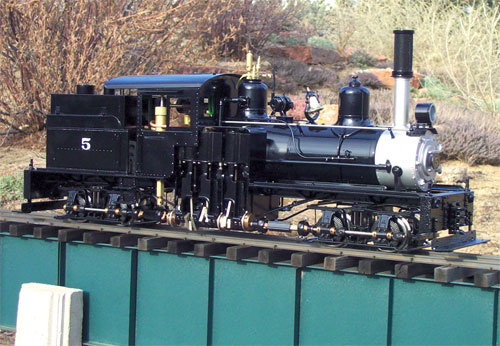Gauge 1, 1:20.3 scale, live-steam Shay
Accucraft Trains
31112 San Clemente St.
Hayward CA 94544
Price: $1,799
Web site: www.accucraft.com
All-metal model based on a Michigan-California Lumber Company Shay; three cylinders; butane-fired boiler; hinged cab roof; displacement lubricator; boiler fittings include safety valve, pressure gauge, water glass, check valve, filler plug; blow-off pressure, 50 psi; hand pump in oil bunker; link-and-pin couplers. Dimensions: length over end beams, 17 7/8″; width, 4 5/16″; height over stack, 8″. In 1:20.3, this works out to 30’3″ x 7’31/2″ x 13’6″, respectively
Pros: Nice looking model; well detailed; sprung trucks; wood grain etched into “wooden” parts; water fill through filler plug or hand pump; boiler well fitted out; very smooth running; powerful engine; easy to operate
Cons: Noisy burner; pressure gauge on wrong side; pump ram too large; roof hinge a little awkward
The engine arrives in a well-packed box. Trucks, spark arrestor, and two or three detail parts are included in a separate box. Installing the trucks is a simple matter of inserting a retaining screw through a supplied spring, then inserting this assembly through the mounting hole in the bottom of the truck and screwing them to the chassis, making sure that the telescoping parts of the drive train are in place.
The cranks are set 120° apart (as opposed to 90° on a two-cylinder engine). This spacing makes the engine a very smooth runner indeed, while the third cylinder adds power. Cylinders are controlled by piston valves. Reversing is accomplished by exchanging admission and exhaust steam via a valve in the cab controlled by the reversing lever. Because of the way the engine is set up, its minimum radius is probably in the 6′ neighborhood.
The boiler is all copper, silver soldered, and the safety valve is set at 50 psi. The engine will run fine on anything over 20 psi. Boiler fittings include all the amenities, as listed above. A Shay locomotive has cylinders only on one side, which will usually influence the way it is put on the track (i.e., cylinders facing out, since the other side is boring). The pressure gauge, though, faces the off side. In my case, that meant I had to use a dental mirror to see it. If you are experienced in such things, it would not be a huge job to reposition the gauge to face out the cylinder side.
Water can be introduced to the boiler via a filler plug atop the steam turret in the cab or through the hand pump in the oil bunker. The latter is accessed by simply lifting off the bunker cover and inserting the included pump handle. Just fill up the reservoir and start pumping. When filling, however, be careful not to fill past the point where the water line exits the reservoir, as there is a largish hole there that will let water leak out onto the cab floor.
The gas tank is in the cab on the left side. It has a standard filler valve and control knob. The tank is close enough to the boiler that the boiler’s heat should keep the tank warm on cooler days.
It was a cool day when I took the engine out to test it, with the temperature in the mid 40s. I oiled it all around, as per the instructions, filled the displacement lubricator with steam oil, and the bunker with distilled water. The ram on the hand pump is very large, so it takes a fair amount of elbow grease to pump the water into the boiler. Personally, I would prefer a smaller, easier pump that required more strokes. However, this is a relatively small point. The pump works well and I soon had water up near the top nut of the sight glass. I filled the gas tank in the usual way, opened the smokebox door, cracked the gas valve, and lit the fire. It snapped back into the flue, just as it should. For the first minute or so, the fire was not too stable, due to liquid butane getting into the line. However, it soon settled down and was quite controllable.
After 12 minutes, the blowoff pressure of 50 pounds per square inch was reached and the safety valve lifted. This being a cool day, the steam effects were grand. I opened the throttle and shifted the lever from forward to reverse two or three times to clear the condensate. (You can do that with this type of engine without fear of damage.) As soon as the cylinders warmed, the engine was off on its own, without even needing a push.
Once going, it was quite controllable. Top speed seemed a little low, even for a Shay, but it was consistent. This may improve some as the engine wears in. I had to turn the fire up quite a way to keep pressure up, and just cracking the throttle kept the engine going at a sedate speed without wasting steam. I suspect that performance would improve somewhat in warmer weather. The run lasted another 15 minutes before both water and gas were exhausted.
The first trial was run light. For the second run, I tied on a dead 0-4-0 steamer, three wagons filled with stone, and a gondola car-not a long train, but a fairly heavy one. Steam was raised this time in five minutes, the engine already being warm. When the throttle was opened, the Shay just walked off with its load. It was obvious that it was capable of a much longer train. The run, fully loaded, lasted an additional 17 minutes before gas and water ran out about simultaneously.
This is a good engine, suitable for beginners. Like all steamers, the more you work with it, the better its performance will be. If Shays appeal to you, this is definitely one to consider.














